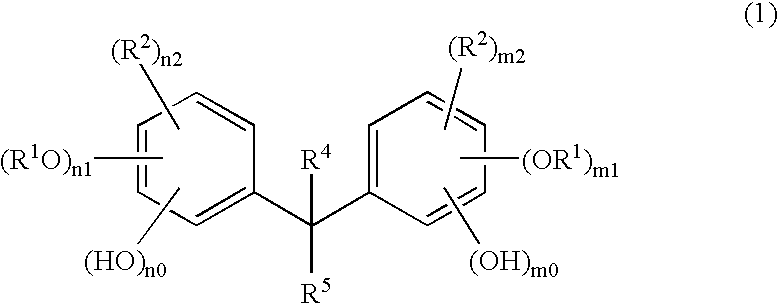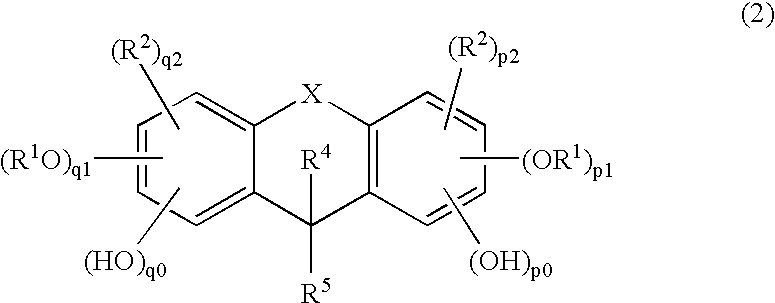Method of manufacturing a semiconductor device
a semiconductor device and manufacturing method technology, applied in the field of resist compounds, can solve the problems of reducing product yield, deteriorating transistor characteristics, difficult control of pattern dimension, etc., and achieve the effects of high heat resistance, high sensitivity, and high resolution
- Summary
- Abstract
- Description
- Claims
- Application Information
AI Technical Summary
Benefits of technology
Problems solved by technology
Method used
Image
Examples
example 1
Synthesis of Compound 5-1
[0103]
(1) Synthesis of 1-(2-naphthyl)-1,1-bis(3-methyl-4-hydroxyphenyl)ethane
[0104] Into a solution prepared by heating a mixture of 43.2 g (0.4 mol) of o-cresol (reagent available from Kanto Chemical Co., Inc.) and 17.1 g (0.1 mol) of β-acetonaphthone (reagent available from Kanto Chemical Co., Inc.) to about 30° C., were added 0.1 ml of sulfuric acid, 0.8 ml of 3-mercaptopropionic acid and 10 ml of toluene. The reaction was allowed to proceed under stirring. After confirming that the conversion reached 100% by gas chromatography, 100 ml of toluene was added. After cooling, the precipitated solid was separated by vacuum filtration, washed with warm water of 60° C. under stirring and purified by silica gel column chromatography, to obtain 24 g of the titled compound.
(2) Synthesis of Compound 5-1
[0105] Into a solution prepared by mixing 1.84 g (5 mmol) of 1-(2-naphthyl)-1,1-bis(3-methyl-4-hydroxyphenyl)ethane synthesized above with 5 ml of anhydrous acet...
example 2
Synthesis of Compound 5-2
[0106]
[0107] Into a solution prepared by mixing 1.84 g (5 mmol) of 1-(2-naphthyl)-1,1-bis(3-methyl-4-hydroxyphenyl)ethane synthesized in Example 1 with 5 ml of anhydrous acetone and 1.2 mg of dimethylaminopyridine, 1.32 g (6 mmol) of di-tert-butyl dicarbonate was added dropwise over 10 min. The resultant mixture was stirred for 24 h at 40° C. The reaction liquid was purified by a silica gel column chromatography (eluent: ethyl acetate / hexane=1 / 3) to obtain the titled compound. The structure of the compound was determined by elemental analysis and 1H-NMR measurement. The results of the analysis are shown in Tables 1 and 2.
example 3
Synthesis of Compound 5-3
[0108]
(1) Synthesis of Biscatechol Compound
[0109] In the same manner as in Example 1(1) except for using 44.0 g (0.4 mol) of catechol (reagent available from Kanto Chemical Co., Inc.) in place of 43.2 g (0.4 mol) of o-cresol, 1-(2-naphthyl)-1,1-bis(3,4-dihydroxyphenyl)ethane was synthesized.
(2) Synthesis of Compound 5-3
[0110] Into a solution prepared by mixing 1.84 g (5 mmol) of 1-(2-naphthyl)-1,1-bis(3,4-dihydroxyphenyl)ethane synthesized above with 5 ml of anhydrous acetone and 1.2 mg of dimethylaminopyridine, 5.28 g (24 mmol) of di-tert-butyl dicarbonate was added dropwise over 10 min. The resultant mixture was stirred for 24 h at 40° C. The reaction liquid was poured into an excessive amount of water to precipitate solid matters. The obtained white powder was washed with distilled water three times, filtered under suction, and dried under reduced pressure, to obtain the titled compound. The structure of the compound was determined by elemental analy...
PUM
| Property | Measurement | Unit |
|---|---|---|
| width | aaaaa | aaaaa |
| molecular weight distributions | aaaaa | aaaaa |
| width | aaaaa | aaaaa |
Abstract
Description
Claims
Application Information
 Login to View More
Login to View More - R&D
- Intellectual Property
- Life Sciences
- Materials
- Tech Scout
- Unparalleled Data Quality
- Higher Quality Content
- 60% Fewer Hallucinations
Browse by: Latest US Patents, China's latest patents, Technical Efficacy Thesaurus, Application Domain, Technology Topic, Popular Technical Reports.
© 2025 PatSnap. All rights reserved.Legal|Privacy policy|Modern Slavery Act Transparency Statement|Sitemap|About US| Contact US: help@patsnap.com



